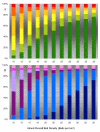Assessing anti-rabies baiting--what happens on the ground?
- PMID: 15113448
- PMCID: PMC407850
- DOI: 10.1186/1471-2334-4-9
Assessing anti-rabies baiting--what happens on the ground?
Abstract
Background: Rabies is one of the most hazardous zoonoses in the world. Oral mass vaccination has developed into the most effective management method to control fox rabies. The future need to control the disease in large countries (i.e. Eastern Europe and the Americas) forces cost-benefit discussions. The 'Increase bait density' option refers to the usual management assumption that more baits per km2 could compensate for high fox abundance and override the imperfect supply of bait pieces to the individual fox.
Methods: We use a spatial simulation, which combines explicitly fox space use (tessellation polygons) and aeroplane flight lines (straight lines). The number of baits actually falling into each polygon is measured. The manager's strategic options are converted into changes of the resulting bait distribution on the ground. The comparison enables the rating of the options with respect to the management aim (i.e. accessibility of baits).
Results: Above 5% (approx. 10%) of all fox groups without any bait (at most 5 baits) relate to the baiting strategy applied in the field (1 km spaced parallel flight lines, 20 baits per km2 distributed) under habitat conditions comparable to middle and western Europe (fox group home-range 1 km2, 2.5 adults; reference strategy). Increasing the bait density on the same flight-line pattern neither reduces the number of under-baited fox group home-ranges, nor improves the management outcome and hence wastes resources. However, reducing the flight line distance provides a more even bait distribution and thus compensates for missed fox groups or extra high fox density.The reference strategy's bait density can be reduced when accounting for the missed fox groups. The management result with the proper strategy is likely the same but with reduced costs.
Conclusion: There is no overall optimal strategy for the bait distribution in large areas. For major parts of the landscape, the reference strategy will be more competitive. In situations where set backs are attributed to non-homogeneous bait accessibility the distribution scheme has to be refined zone-based (i.e. increase of the flight line length per unit area). However, increase in bait density above the reference strategy appears inappropriate at least for non-urban abundance conditions of the red fox.
Figures






Similar articles
-
The spatial and temporal disappearance of different oral rabies vaccine baits.Berl Munch Tierarztl Wochenschr. 2004 Sep-Oct;117(9-10):360-6. Berl Munch Tierarztl Wochenschr. 2004. PMID: 15495926
-
Wild carnivore acceptance of baits for delivery of liquid rabies vaccine.J Wildl Dis. 1990 Oct;26(4):486-501. doi: 10.7589/0090-3558-26.4.486. J Wildl Dis. 1990. PMID: 2250325
-
Comparison of the effectiveness of two protocols of antirabies bait distribution for foxes (Vulpes vulpes).Vet Res. 1998 Nov-Dec;29(6):537-46. Vet Res. 1998. PMID: 9851010
-
Oral vaccination against rabies and the behavioural ecology of the red fox (Vulpes vulpes).J Vet Med B Infect Dis Vet Public Health. 2003 Dec;50(10):477-83. doi: 10.1046/j.1439-0450.2003.00712.x. J Vet Med B Infect Dis Vet Public Health. 2003. PMID: 14720184 Review.
-
[The development of strategies for the field application of oral immunization of foxes against rabies].Schweiz Arch Tierheilkd. 2000 Aug;142(8):439-46. Schweiz Arch Tierheilkd. 2000. PMID: 11004892 Review. German.
Cited by
-
Control and elimination of rabies in Croatia.PLoS One. 2018 Sep 20;13(9):e0204115. doi: 10.1371/journal.pone.0204115. eCollection 2018. PLoS One. 2018. PMID: 30235274 Free PMC article.
-
Factors influencing the success of aerial rabies vaccination of foxes.Sci Rep. 2017 Oct 30;7(1):14376. doi: 10.1038/s41598-017-14615-2. Sci Rep. 2017. PMID: 29085017 Free PMC article.
-
Eliminating rabies in Estonia.PLoS Negl Trop Dis. 2012;6(2):e1535. doi: 10.1371/journal.pntd.0001535. Epub 2012 Feb 28. PLoS Negl Trop Dis. 2012. PMID: 22393461 Free PMC article.
-
Spatial pattern formation facilitates eradication of infectious diseases.J Appl Ecol. 2008 Apr 1;45(2):415-423. doi: 10.1111/j.1365-2664.2007.01439.x. J Appl Ecol. 2008. PMID: 18784795 Free PMC article.
-
2008-2011 sylvatic rabies epidemic in Italy: challenges and experiences.Pathog Glob Health. 2013 Oct;107(7):346-53. doi: 10.1179/2047772413Z.000000000175. Pathog Glob Health. 2013. PMID: 24392677 Free PMC article.
References
-
- Stöhr K, Meslin FM. Progress and setbacks in the oral immunisation of foxes against rabies in Europe. Vet Rec. 1996;139:32–35. - PubMed
-
- Vos A, Müller T, Schuster P, Schlüter H, Neubert A. Oral vaccination of foxes against rabies with SAD B19 in Europe, 1983-1998: a review. Veterinary Bulletin. 2000;70:1–6.
-
- Wandeler A. Epidemiology of fox rabies. In: Zimen E, editor. Biogeographica Vol18 - The Red Fox. The Hague, Dr.W.Junk B.V. Publishers; 1980. pp. 237–250.
-
- Winkler WG, Bögel K. Control of rabies in wildlife. Sci Am. 1992;266:56–62. - PubMed
-
- Johnston DH, Voigt DR, MacInnes CD, Bachmann P, Lawson KF, Rupprecht CE. An aerial baiting system for the distribution of attenuated or recombinant rabies vaccines for foxes, racoons and skunks. Rev Infect Dis. 1988;Suppl 4:660–664. - PubMed
MeSH terms
Substances
LinkOut - more resources
Full Text Sources
Medical

